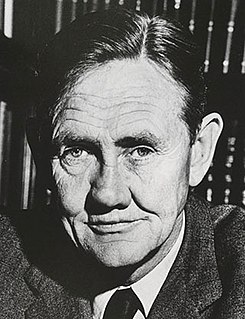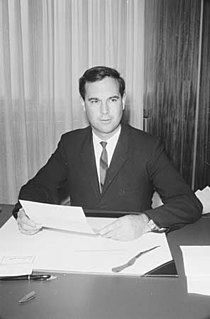
Edward Gough Whitlam was the 21st Prime Minister of Australia, serving from 1972 to 1975. The Leader of the Labor Party from 1967 to 1977, Whitlam led his party to power for the first time in 23 years at the 1972 election. He won the 1974 election before being controversially dismissed by the Governor-General of Australia, Sir John Kerr, at the climax of the 1975 Australian constitutional crisis. Whitlam remains the only Australian prime minister to have his commission terminated in that manner.

The 1975 Australian constitutional crisis, also known simply as the Dismissal, has been described as the greatest political and constitutional crisis in Australian history. It culminated on 11 November 1975 with the dismissal from office of the Prime Minister, Gough Whitlam of the Australian Labor Party (ALP), by Governor-General Sir John Kerr, who then commissioned the Leader of the Opposition, Malcolm Fraser of the Liberal Party, as caretaker Prime Minister.
Francis Patrick Vincent McManus, Australian politician, was the last leader of the parliamentary Democratic Labor Party and a prominent figure in Australian politics for 30 years.
A joint sitting of the Australian parliament was convened in 1974, in which members of the Senate and House of Representatives sat together as a single legislative body. The joint sitting was held on 6 and 7 August 1974, following the double dissolution 1974 federal election, and remains the only time that members of both houses of the federal parliament have sat together as a single legislative body pursuant to section 57 of the Constitution.

The Whitlam Government was the federal executive government of Australia led by Prime Minister Gough Whitlam. It was made up of members of the Australian Labor Party. The government commenced when it defeated the McMahon Government in the 1972 federal election after a record 23 years of Coalition government. It concluded in historic circumstances, when it was dismissed by Governor-General Sir John Kerr as a result of the 1975 constitutional crisis and was succeeded by the Fraser Government. The Whitlam Government remains the only federal government in Australian history to be dismissed by either a monarch or viceregal representative.

Federal elections were held in Australia on 30 November 1963. All 122 seats in the House of Representatives were up for election. The incumbent Liberal–Country coalition government, led by Prime Minister Robert Menzies, won an increased majority over the opposition Labor Party, led by Arthur Calwell.

Condon Bryan Byrne, Australian politician, was a Senator for the Australian Labor Party and later the Democratic Labor Party. Prior to entering politics he was private secretary to Vince Gair who was then Premier of Queensland.

Federal elections were held in Australia on 10 December 1977. All 124 seats in the House of Representatives and 34 of the 64 seats in the Senate were up for election.

Federal elections were held in Australia on 25 October 1969. All 125 seats in the House of Representatives were up for election. The incumbent Liberal–Country coalition government, led by Prime Minister John Gorton, won the election with a severely diminished majority over the opposition Labor Party, led by Gough Whitlam. Both major parties had changed their leaders in the run-up to the election, the first time this had occurred since 1946.
The Queensland Labor Party (QLP) was a political party of Queensland, Australia formed in 1957 by a breakaway group of the then ruling Labor Party Government after the expulsion of Premier Vince Gair. In 1962 the party became the Queensland section of the Democratic Labor Party (DLP). The party continued to hold seats in the Queensland state parliament until 1972, then suffered a collapse in its vote and wound itself up in 1978.
Bertie Richard Milliner was an Australian trade unionist, politician and Senator, representing the Australian Labor Party (ALP). He would have been a minor figure in Australia’s political history but for the events that followed his sudden death. These circumstances contributed to the 1975 Australian constitutional crisis, which culminated in the dismissal of the Prime Minister, Gough Whitlam, by the Governor-General, Sir John Kerr.
This is a list of members of the Australian Senate from 1974 to 1975. The 18 May 1974 election was a double dissolution of both Houses, with all 127 seats in the House of Representatives, and all 60 seats in the Senate up for election. The incumbent Labor Party led by Prime Minister Gough Whitlam defeated the opposition Liberal Party led by Billy Snedden and their Coalition partner the Country Party led by Doug Anthony.
This article provides information on candidates who stood for the 1975 Australian federal election. The election was held on 13 December 1975.

The Gair Affair was an episode in Australian political life in 1974, during the government led by the Labor Prime Minister Gough Whitlam. Whitlam offered the post of Ambassador to Ireland to a non-government senator from Queensland, Vince Gair, in the hope that this would improve Labor's chance of gaining a majority in the Senate at the forthcoming general election. Whitlam's plan was foiled by the Premier of Queensland, Joh Bjelke-Petersen, during what came to be known as "The Night of the Long Prawns", but the matter was overtaken by events when Whitlam decided to call a double dissolution election.

The Fraser Government was the federal executive government of Australia led by Prime Minister Malcolm Fraser. It was made up of members of a Liberal-Country party coalition in the Australian Parliament from November 1975 to March 1983. Initially appointed as a "caretaker" government following the dismissal of the Whitlam Government, Fraser won in a landslide at the resulting 1975 Australian federal election, and won substantial majorities at the subsequent 1977 and 1980 elections, before losing to the Bob Hawke-led Australian Labor Party in the 1983 election.

The McMahon Government was the period of federal executive government of Australia led by Prime Minister William McMahon of the Liberal Party. It was made up of members of a coalition between the Liberal Party and the Country Party, led by Doug Anthony as Deputy Prime Minister. The McMahon Government lasted from March 1971 to December 1972, being defeated at the 1972 federal election. Writing for the Australian Dictionary of Biography, Julian Leeser describes McMahon's prime ministership as "a blend of cautious innovation and fundamental orthodoxy".
The history of the Australian Labor Party has its origins in the Labour parties founded in the 1890s in the Australian colonies prior to federation. Labor tradition ascribes the founding of Queensland Labour to a meeting of striking pastoral workers under a ghost gum tree in Barcaldine, Queensland in 1891. The Balmain, New South Wales branch of the party claims to be the oldest in Australia. Labour as a parliamentary party dates from 1891 in New South Wales and South Australia, 1893 in Queensland, and later in the other colonies.



















